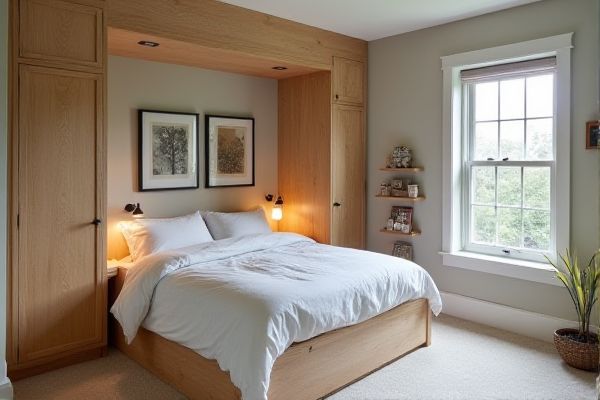
Murphy beds save floor space by folding vertically against the wall, ideal for small rooms needing multifunctionality, while trundle beds offer an extra sleeping surface that slides out horizontally, perfect for accommodating guests without permanent space loss. Explore the full article to find out which option best suits Your space and lifestyle.
Table of Comparison
| Feature | Murphy Bed | Trundle Bed |
|---|---|---|
| Design | Wall-mounted fold-up bed | Under-bed pull-out bed |
| Space-saving | Frees floor space when stored vertically | Uses under-bed space, needs clearance to pull out |
| Installation | Requires wall installation | No installation, fits under a standard bed |
| Comfort | Standard mattress; similar to regular beds | Typically thinner mattress; less cushioning |
| Price Range | Moderate to high ($800 - $3000+) | Affordable ($150 - $700) |
| Usage | Ideal for multi-functional rooms | Best for occasional guests or small spaces |
| Durability | Robust frame, long-lasting | Less sturdy, depends on construction |
Introduction to Murphy Beds and Trundle Beds
Murphy beds are wall-mounted, space-saving beds that fold vertically into a cabinet, ideal for maximizing floor space in small rooms or studios. Trundle beds feature a low-profile frame with a hidden bed stored underneath, easily pulled out to accommodate guests without sacrificing daily living space. Choosing between a Murphy bed or a trundle bed depends on your room size, usage needs, and how often you require additional sleeping arrangements.
Space-Saving Features Compared
Murphy beds fold vertically against the wall, freeing up floor space entirely when not in use, making them ideal for rooms requiring maximum open area. Trundle beds feature a lower bed tucked under a main bed, providing dual sleeping spaces without needing additional floor space but occupying more room than a Murphy bed when both beds are pulled out. Your choice depends on whether you prioritize complete room clearance or flexible sleeping arrangements.
Comfort and Mattress Options
Murphy beds offer the advantage of accommodating standard mattresses that prioritize comfort, such as memory foam or hybrid options, ensuring a restful night's sleep when pulled down. Trundle beds typically use thinner, more compact mattresses designed for occasional use, which may sacrifice some comfort but save space effectively. Your choice between the two should consider how frequently the bed will be used and the mattress quality that meets your comfort needs.
Design and Aesthetic Differences
Murphy beds offer a sleek, space-saving design that folds vertically into a wall or cabinet, seamlessly blending with your room's decor while maintaining a minimalist aesthetic. In contrast, trundle beds feature a secondary mattress stored underneath the main bed, emphasizing practicality with a bulkier look that works well in casual or children's rooms. Your choice depends on whether you prioritize sophisticated elegance or functional versatility in your bedroom design.
Mechanism and Ease of Use
Murphy beds operate by folding vertically into a wall or cabinet using spring or piston mechanisms, offering smooth deployment and space-saving benefits ideal for small rooms. Trundle beds feature a lower bed on wheels that slide out from beneath a standard bed frame, allowing quick setup without lifting or heavy effort. Your choice depends on whether you prioritize wall-mounted convenience with a Murphy bed or the simple pull-out functionality of a trundle bed.
Durability and Maintenance
Murphy beds typically feature sturdy wall-mounted mechanisms crafted from robust materials like hardwood or metal, offering long-term durability with minimal maintenance required beyond occasional hardware checks. Trundle beds, often constructed with lighter frames and rolling components, may require more frequent upkeep to ensure smooth operation and prevent wear on casters and sliding tracks. Choosing between the two, consider your space usage and maintenance preferences to ensure your bed remains functional and durable over time.
Cost Comparison
Murphy beds generally involve higher upfront costs due to their complex wall-mounted design and installation requirements, often ranging from $1,000 to $3,000 or more. Trundle beds tend to be more budget-friendly, with prices typically between $200 and $700, as they are simpler, freestanding furniture pieces. Your choice depends on the balance between space-saving needs and budget constraints, with trundle beds offering a more economical solution for guest accommodations.
Best Use Cases and Room Suitability
Murphy beds are ideal for maximizing space in small rooms or studios where floor area needs to be fully utilized during the day. Trundle beds suit guest rooms or children's rooms, providing an extra sleeping surface without taking up additional space when not in use. Your choice depends on room size and the frequency of overnight guests, with Murphy beds offering a sleek vertical solution and trundle beds providing flexible, horizontal sleeping arrangements.
Pros and Cons of Murphy Beds
Murphy beds save valuable floor space by folding vertically into the wall, making them ideal for small apartments and multi-use rooms. They provide a comfortable, full-sized sleeping surface but can be costly to install and require wall mounting, which limits placement options. Your decision hinges on prioritizing space efficiency and sleek design over the ease and lower cost of a trundle bed.
Pros and Cons of Trundle Beds
Trundle beds offer space-saving benefits by providing an extra sleeping surface that easily tucks away under the main bed, making them ideal for small rooms or guest accommodations. They are typically more affordable than Murphy beds and simpler to set up, but may require additional floor space when the lower bed is pulled out and often lack the wall-mounted design that saves room vertically. Comfort can be a concern since trundle mattresses tend to be thinner, and frequent use may affect the longevity of both mattresses and frames.
 homyna.com
homyna.com